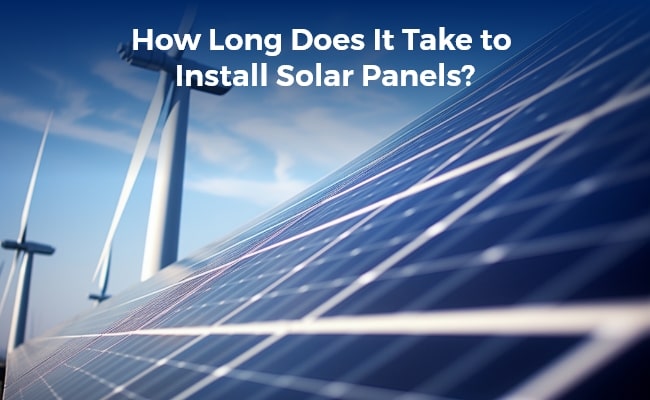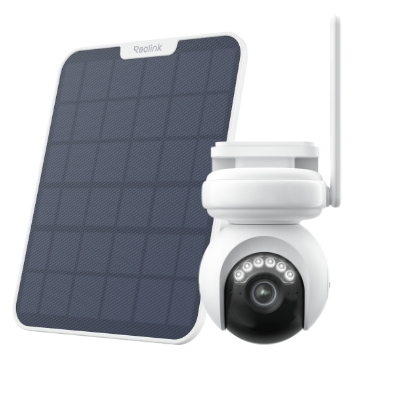How Long Does It Take to Install Solar Panels? A Comprehensive Guide

Solar panels are one of the greatest inventions that help you make free electricity with renewable energy resources. However, to ensure optimum production, it is mandatory to know some crucial factors, such as how long a solar panel installation takes and its essential steps. The article will explore all such information for your help.
- How Long Does It Take to Install Solar Panels?
- How Long Does It Take to Install Commercial Solar Panels?
- What Impacts the Time Required to Install Solar Panels?
- Common Places for Solar Panel Installation
- Solar Panel Installation Process Breakdown
- How Long Does It Take Homeowners Who Install Solar Panels to Recover Their Investment?
- FAQs
- Conclusion
How Long Does It Take to Install Solar Panels?
The installation of solar panels can take from 4 weeks to a few months. The exact time frame depends upon various elements, such as site assessments and evaluating factors like roof conditions and space exposure to the sun.
Then, the homeowner has to collaborate with the installation company to obtain all the installation's legal requirements, which might vary from area to area. In addition, significant time is also needed to purchase the necessary equipment, such as high-quality solar panels, inverters, mounting systems, and investigating an efficient installation company.
In addition, multiple external factors, such as the size of the system, complexity level, unforeseen weather conditions, etc., can influence the time frame.
Installing solar panels for security cameras is quick and straightforward. For instance, the new Reolink Altas PT Ultra, a battery-powered camera with a 20,000 mAh battery, is compatible with the Reolink Solar Panel.
Industry-leading 4K Continuous Recording Battery Camera
4K UHD Continuous Recording; ColorX Night Vision; Pan & Tilt; Automatic Tracking; All Recordings Stored Locally.
How Long Does It Take to Install Commercial Solar Panels?
The total duration of the commercial solar panel installation can be between 1 and 3 months, depending upon multiple factors. The process begins with the site inspection, where various factors are considered, such as space structure, shading, etc.
Next, all the essential permits are obtained, which can vary from location to location. The actual installation phase involves:
- Mounting the components, such as panels.
- Writing panels and existing infrastructure together.
- Connecting them with the grid system can take anywhere between 2 weeks and one month.
In addition, multiple factors, such as weather conditions and instant challenges, can impact the installation's size, complexity, and timeline.
What Impacts the Time Required to Install Solar Panels?
Some of the possible factors which can increase or decrease the installation time of solar panels include the following:
- HOA approval: Homeowners Association Approval (HOA) can be a big player in increasing or correlating installation timeline,
- Roof type: Different roofs, such as flat, sloped, or metal, can affect the installation time due to their carrier mounting requirements and structural conditions.
- Solar equipment type: The complexity of the solar equipment you use in the process can also significantly impact the installation duration.
- System size: Larger solar panels and equipment need more time to be mounted than smaller ones.
- Weather conditions: Inconsistent and adverse weather conditions, such as rain or high wind, can delay installation.
- Installer efficiency: The experience of the installation team can also impact the installation timeline. While skilled workers need less time, inefficient workers consume more hours.
Common Places for Solar Panel Installation
Some of the familiar places where you can install your solar panels include:
- On a roof: Solar panels installed on residential and commercial roofs are directly exposed to sunlight, which can be used to generate the maximum possible electricity.
- On the ground: Installing the panels on open grounds like backyards helps to position the panels more flexibly and adjust the angle according to the sun's position at different times of the day.
- On the wall: Panels can be installed on the walls, especially in urban areas where spaces are limited. They help utilize vertical surfaces while not compromising production quantity or quality.
Solar Panel Installation Process Breakdown
Many people think solar panel installation is straightforward; all that is needed is the purchase of components and getting it fixed anywhere. However, this is different because there are multiple steps involved, as discussed below.
1. Site assessment
The solar panel needs to be installed in a place that can grant them direct exposure to the sun. The same is why, when you book an installation session, one of their site assessors visits your place before the installation date to examine the space.
Once they find the accurate angle and ensure that your roof can handle the weight, they will confirm the next steps.
2. System engineering
Engineers will calibrate the designs and engineering needs according to your roof structure using the data collected. The city authorities will then approve these designs. The verification duration depends on how simple or complex the installation plan is.
3. Getting legal permits
The household needs approval from the local Building and Safety Department to apply for solar billing. This is the longest phase of the installation process, which might take 2 weeks to 4 months.
4. Solar panel installation
Once you have obtained all the permits, your selected company will schedule a date to install the equipment. Depending on how many solar plates you will install, the installation process takes 5 to 7 hours.
Suppose you transfer the whole house's energy system to a solar panel. In that case, the installation might continue the next day.
5. Final inspection
After the installation, a building inspector will visit your space to ensure the solar panels are correctly installed. Some cities might also involve more inspection sessions to ensure the process went well while adhering to the legal requirements.
6. Permission for the solar billing
Lastly, you must apply with your utility company to switch your house's complete system from the grid to solar billing.
Once the company receives your application, it will notify you about the approval, after which you can finally start consuming the benefits. The verification can take 2 days to 2 weeks.
How Long Does It Take Homeowners Who Install Solar Panels to Recover Their Investment?
Homeowners usually recover their investment within 6 to 10 years, depending on factors like system cost, local electricity charges, available incentives, government support, etc. Recovery is quick in areas where electricity costs are high. However, in countries with lower rates, it can take a decade.
FAQs
Can solar panels be installed in one day?
Solar panels can not usually be installed in one day because multiple steps can take days to weeks. Although the physical mounting is a one-day process, the initial permissions can take much time.
How long does a solar system take to install?
The solar system's complete installation can take 1 to 3 months. The process includes site assessment, taking permissions, and arranging for installation. In addition, there are multiple factors which can further impact the installation timeline.
How long does it take to activate solar panels after installation?
Activating the solar panels after installation takes a few days to a week. The time frame allows for the completion of multiple inspections, permission, and, finally, connecting the system with the rest of the house energy system.
Conclusion
The installation of solar panels for residential and commercial usage can take 1 to 3 months, depending upon various factors. It includes procuring the material like panels, inverters, etc., acquiring all the legal permissions, hiring an efficient installation firm, etc., which we discuss above in the content.
Please share this ultimate guide with your family and friends if you find it helpful. Also, please express your valuable feedback in the comment section below.
Search
Subscribe for the Latest Updates
Security insights & offers right into your inbox

